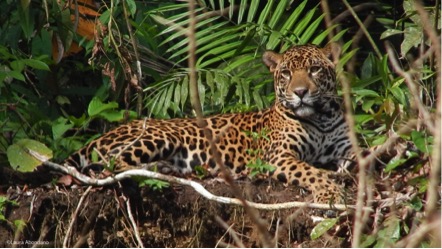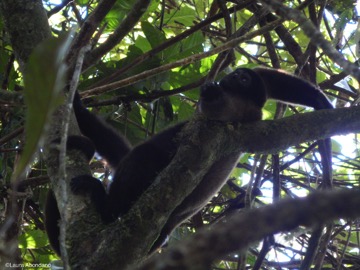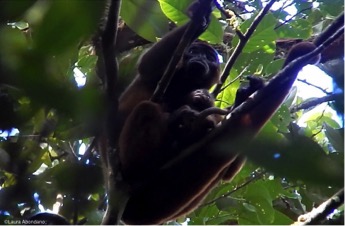Grantee Spotlight: Research Grant 2017 – Laura Abondano
Mating strategies and reproductive endocrinology of female lowland woolly monkeys (Lagothrix logotricha poeppigii): Implications for female mate choice in a promiscuous primate.
Research Update: Woolly Monkey Mating Season and the Perks of Field Work in the Amazon Rainforest, Laura Abondano
The Amazon is a notoriously wet and humid place, I mean it’s called a RAINforest after all. However, between the months of July and August, our field site receives the least amount of rainfall of the year and it can get really hot! Perhaps this is the reason why our study subjects, woolly monkeys (Lagothrix lagotricha poeppigii), are being so lazy this month. Woolly monkeys typically spend about a third of their day travelling. However, during the past few days of behavioral follows some individuals, like the subadult male in the photo below, have been spending most of their time either resting or foraging in the same area and moving for only short periods of time. After all, who want to be moving around trees when it’s so hot out there!
Woolly monkeys are not the only ones finding the summer heat to be exhausting. While traveling into our field site, we were lucky to encounter the ‘King of the Forest’ as we were traveling down the Tiputini River. August and January are the months of the year when you are most likely to see jaguars (Panthera onca), since during these months when the river levels are lowest that there are more exposed beaches for these felines to find a spot to cool off.
As average temperatures being to go down in September, we hope to see the woolly monkeys become more active. It is around this time of year when we start to note an increase in sexual activity, and see females start soliciting copulations more frequently from multiple (if not all) males in the social group. With two field assistants, we are eager to start recording these behaviors and to be collecting faecal samples in order to characterize female’s ovulation cycles. Using both behavioral and endocrinological data, we hope to determine whether females are choosing to mate with particular males when they are most fertile (i.e., around the time of ovulation), while mating with other males outside their fertility peak – perhaps to confuse paternity and obtain benefits (such as food sharing or protection) from multiple males once their babies are born.
For regular updates on her work and that of other woolly monkey researchers – check out the MonoChorongo blog!

All photographs © Laura Abondano 2017


